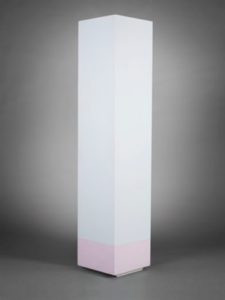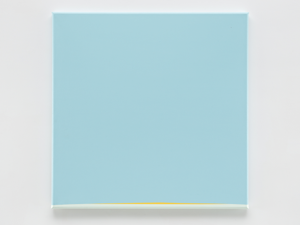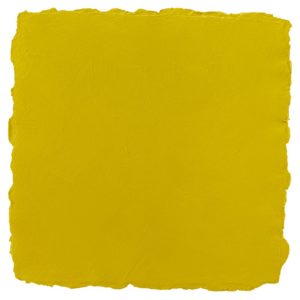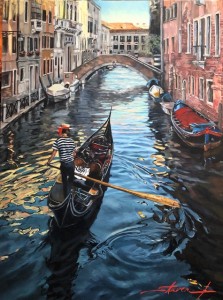Dear Artist,
In 2003, when Anne Truitt was 82, she wrote a letter to her daughter: “Something strange is happening to me. Certain ways in which I have made my work ever since 1961 have simply — very simply, silently and without saying goodbye — departed from me.” For four decades, she’d innovated and advanced the principles of colourfield painting with near-perfect, immersive canvases and minimalist, colour-blocked sculptures. Now, suddenly, intuitively and almost as if involuntarily, she pivoted towards a new, multi-sensory painting experience. “It’s as if a person had decisively walked quietly out of a room I am used to living in and in which I were thoroughly accustomed to a powerful presence,” she wrote. “I am surprised. What is left is ‘sound,’ some kind of energy without name. More force, no name.”
Anne was accustomed to articulating her interior world. At 53, she’d started keeping a journal about the ups and downs of studio life. At the time, she had a couple of major retrospectives freshly under her belt, but felt overwhelmed with the balancing act of creative life, motherhood and marriage. She published her journals in three volumes between 1982 and 1996.
Now, in her 80s, the quiet departure of a decades-long creative investigation was like the completion of a love affair. Once underway, she understood the purpose and inevitability of this ending and began anew with a series of works on rough paper, brushed with thick monochromes of saturated colour. After some time with them, their name came to her. “Yesterday while walking around, it occurred to me that the ‘name’ of the things I am making out of the beautiful delicate strong paper…is SOUND.” Anne Truitt died the following year, at age 83.
Sincerely,
Sara
PS: “Artists have no choice but to express their lives.” (Anne Truitt)
Esoterica: “There’s a small, still center into which conception can arrive. And when it arrives, you make it welcome with your experience,” wrote Anne in her journal. Staying susceptible to the ending and beginning of each creative direction releases an artist from the dangerous traps of style, replication and rote production. If we are each a vessel for these seeds of expression, as Anne says, it’s our experience that will determine how each is brought to life. “The [artists’] essential effort is to catapult themselves wholly, without holding back one bit, into a course of action without having any idea where they will end up. They are like riders who gallop into the night, eagerly leaning on their horse’s neck, peering into a blinding rain. And they have to do it over and over again.”
Anne Truitt’s Daybook: The Journal of an Artist, is here.
Have you considered a Premium Artist Listing? With each letter, an artist is featured at the bottom of this page. The Premium Artist Listings are a means of connecting artist subscribers through their work. Proceeds from each listing contribute to the production of The Painter’s Keys.
“By keeping on being what we most intimately are, we can continually redefine ourselves so that we become what we have not been able to be. If we live this way, we surprise ourselves” (Anne Truitt)
Featured Artist
A professional painter in both watercolor and oil for over 35 years, I have been creating plein air workshops in Europe for artists to join me since 1996. Plein air is one of the most exciting methods of painting, and I teach a very easy to learn way of capturing the light quickly, that any artist can apply to their own work during our adventures to Europe. Travel for artists is a great way to immerse yourself in painting and make great advances in your techniques by watching other professionals work, and by sharing your own ideas with other artists we all grow! Authentic locations, such as a 12th Century Castle in Ireland, a French Maison in the countryside of France, or an Italian Villa in an historic hilltop village in Italy are carefully chosen. We want our artists and non-painting guests to feel relaxed and at home, with en-suite bedrooms, excellent chef prepared cuisine, and convenient transfers to painting and exploring locations so you can be where you want to be to create. Join me on our next exciting journey!








23 Comments
I love the rush of the horse ride but that is not where art is. It’s in what the artist holds when the horse slows down, when the artist delivers what the ride has meant to him/her. Anne Truitt’s work — yours — mine — must be judged not by exhilarating experiences but by what the artist can make of them, in this case Truitt’s acrylics, not her daybook.
good point. And the acrylics are … disappointing, to say the least. I rather think what happened to Ms. Truitt was that she got tired (understandable at 82) or maybe just lazy and decided to ride on her reputation for awhile instead of doing any actual work.
I had a look at her book on Amazon. It sounds like a very interesting read. I cannot appreciate her paintings shown in this painters keys. Why would an artist paint a block of yellow…..even if they love the colour…or red or blue? I don’t understand it….maybe I will some day.
Of course you understand it perfectly!
It’s a block of rather mustardly looking yellow on rough substrate….
The question really is….so what?
I ha e been fascinated by Anne Truit’s work for a long time now. Oddly enough, I’ve not had a chance to see it in person, as yet – at the top of my bucket list. Having said that, I have read her journals and various of her other writings and can sense exactly what she sought through her work,
Her “ blocks” are not just pieces of wood with straight out-of-the-tube paint slapped on them. Rather, they are multiple, fine layers of subtle, hand -mixed color that glow with a life of their own. I understand her work as an exploration of perception of the subtlest kind through color, affected by light and shadow and our willingness to sit with it to really see.
pretty words don;t justify sloppy, lazy work.
You all may think her blocks of color are nonsense, but they got you all to think and talk!
Painting is. Mark-making is. Many artists simplify as they age, eliminating the busywork that has consumed time and attention for so many years. Consider Matisse, who simplified his work at the end of his life. Taking advantage of everything he learned over the years.
Sara,
Interesting article. Reminds me of the way I’ve been working for years…following my ‘inward voice’…with no specific goal or objective in mind…but letting the work ‘tell’ me where to go.
For years now I’ve had a specific starting point…a photograph of some landscape detail…recently a close-up of tree forms. Example: Did a series of 10 paintings each starting with the same close-up…then allowing each take their own direction. The paintings are similar…but no two are alike. (My gallery in Minneapolis – below – has examples of two sets of paintings. The two larger images are from the same starting point. And the two smaller horizontals are the more recent…based on a small painting I did 20 some years ago which was derived from a photograph of the under-side of a bush. These two also had the same small painting as a starting point.)
Ohhhhhhhh – that’s what “it” is. Thank you, Sara, for writing about this topic.
I once painted a series of large abstract works without knowing what they were or why I was doing them . I just painted. A month later it hit me. Unintentionally, I had expanded a previous recurring theme (waving lines) by going deeper inside it. During the exploration process I found whatever I was doing only worked with certain colours of the spectrum. After finishing, I realized that I had unintentionally travelled Inside the wavelengths. The works were an expression of the interaction of energy inside a bigger structure. The realization was like an arrival to a place of home.
I had no idea that art could be expressed without knowing what you were doing.
Right now is a perfect time to let go.
I may not understand exactly why Anne Truitt made colour blocks, but it’s true that a saturated colour, whatever it is, gives a flash of ‘tuning in’. Pure colour certainly makes me take a mental gasp, think of that deep blue sky after sunset. You certainly do feel something when you look deep into a clean colour. I think she was onto something there!
Hi, Sara — Thank you! I’m now 79 and for 36 years I recreated early music. Now, during this pandemic, I find myself not making much music and was puzzled why. Your insightful article has helped me suddenly realized that I am in a new place now. And music can take on a much more meaningful expression if I let it! Wow! I have followed your father’s and now your musings for decades and find them most thought provoking. Thank you.
Love the use of the phrase, “creative investigation.” That sums up the artistic life quite nicely!
Struggle as I may, I cannot but treat these examples of contemporary art as being “con” art. If art likes this is a reflection of the creative modern mind, then we are indeed in an era of Darwinian regression.
agreed. Lazy, almost insulting.
Here I am at 88 years young having the time of my life, painting every day and painting joyfully, joyfully,something I did not do in my younger years, but now I appreciate and have gratitude to the Universe for having each day anew to paint what I WANT TO PAINT and loving it. Thank you, God, for giving me this creative gift. Gerri Bradford 11/20/2020
Recently I was on an Art Gallery tour in Los Angeles.
In one particular gallery there was a small. Unframed 14 x 20 blue canvas on a 10 x 12 ft white wall .It was a featured painting . I didn’t inquire about the price because I felt that my incredulous expression would give me away .
I appreciate your article Sara it just stated the information . The reader could do what they wanted with it .
Just ordered the book, thanks for sending the link. I love to read about other artist’s perceptions on the insightful renderings on making art. A blogger myself since signing on with internet 15 years ago, I discovered my writing about life as an artist was not the same as others. I have wondered often if it is better to write more surface things regarding art when it goes into a public domain. Pouring out my personal views and responses to how my hours in the studio, or outside of it, isn’t appropriate with regards to marketing my work. Do I sound like I am whining? Do I hinder the quality of my artistic worth? Should I, like so many others, blog about successes and sound like being an artist is the next best thing to Queen of the World. So I stopped blogging. There is so much more to this gig we do in making art than what our hands physically produce. I’m really looking forward to this book, thank you, Sara!
I read Anne Truitt’s books before I saw her work. I have no doubt that these works were done with great dedication, talent and personal sacrifice. They resonate with me. I don’t respond to every work of art that I see, but whe I try to understand the artist, the art and the time in which it was done I am likely to learn something.
I am sorry that some people who don’t happen to respond to this particular work call it lazy, sloppy or almost insulting. It is none of these. If you truly want to see what makes this work “tick”, reading her journals would be a good place to start.
We artists are all on the same journey. Creative investigation is such a privilege and there is room for all.
I doubt if Anne’s work can truly be appreciated through the internet. It reminds me of your work Sara. The dance of the layers just are not visible with photography.
Interesting post on many levels. Thank you Sara.
I’ve seen Anne Truitt’s sculptural work and loved them. I also loved reading her journals. As an artist, it is so good to know that every artist goes through ups and downs and still he/she gets up and shows up again. I had no idea that at the age of 82, in the last year of her life, she abandoned her most well-known series and started such a completely different work. I think that’s completely brave and heroic. It’s exactly how I hope I will be at that stage in my life.
I think anyone who judge someone else’s work without experiencing it in person are lazy, and are potentially missing the world of sensory experience and lasting discoveries. They should, at least, see them in person, give them a chance with an open mind, and spend time with them, before making up their mind, and say things like lazy or sloppy.
AMEN, Kay.